A hearty welcome to Deviant Ollam, of The CORE Group, as he contributes a 3-part series about “Flying with Firearms”. As a well-known security lecturer, trainer, and gun aficionado, he brings the most complete knowledge dump you will find anywhere on the web of how to take your firearms with you when you fly. He is a long time reader of TFB and will likely answer questions you may have in the comments.
**tip: you can right click on images and open them in a new tab to see the higher resolution versions…
–Tom R, EIC
Background
With the NSSF SHOT Show on the horizon, it is likely that many TFB readers will find themselves packing for a flight to Las Vegas this January. There have been sporadic reports of hotels on the strip who are considering new measures that seek to screen guests for guns, but if that doesn’t dissuade you from transporting your favorite lead accelerator in your luggage, perhaps it’s time we had a brief discussion about flying with firearms.

Flying with firearms is safe and legal. If you have any concerns about approaching the counter with your gun case, let me put them to rest.
For much of my life, I have been traveling throughout this country and around the globe, and for over a decade now, whenever it was permissible, I have packed firearms in my checked baggage. I have logged nearly a million miles in the sky with guns at this point, and starting in 2009 I began lecturing and writing extensively about the lifestyle of jet-setting-while-armed.
By and large, this is a smooth process wherever you go within the United States. Many individuals have written to me and expressed relief and joy over what proved to be an unremarkable trip when previously they may have harbored concerns about the treatment they would receive at the airport. Knowing what to expect is a big help, and in this series of articles for TFB, I hope to arm you with wisdom, tips, and advice that will help ensure your flights with firearms go as smoothly as a copper-jacketed bullet down a Melonite-treated bore.

This author and his wife can be frequently found in airports throughout the country… with locked Pelican cases at their sides.
Yes, This is Completely Legal
Just in case anyone out there doubts me, let me direct you to the FAA’s page on this topic, the TSA’s page on this topic, and previous content posted here at TFB.
Not only is flying with firearms a splendid way of exercising your 2nd Amendment rights while you enjoy your freedom to travel, but it also can offer you increased peace of mind. While everybody else’s luggage may be subject to unwanted attention by those who would rifle through it in search of valuables to potentially liberate, your gun case gets to fly completely, and totally, locked. I, for one, love the sight of my Pelican case on the baggage ramp next to my aircraft when I can see the twinkle of gleaming steel padlocks on each hasp.
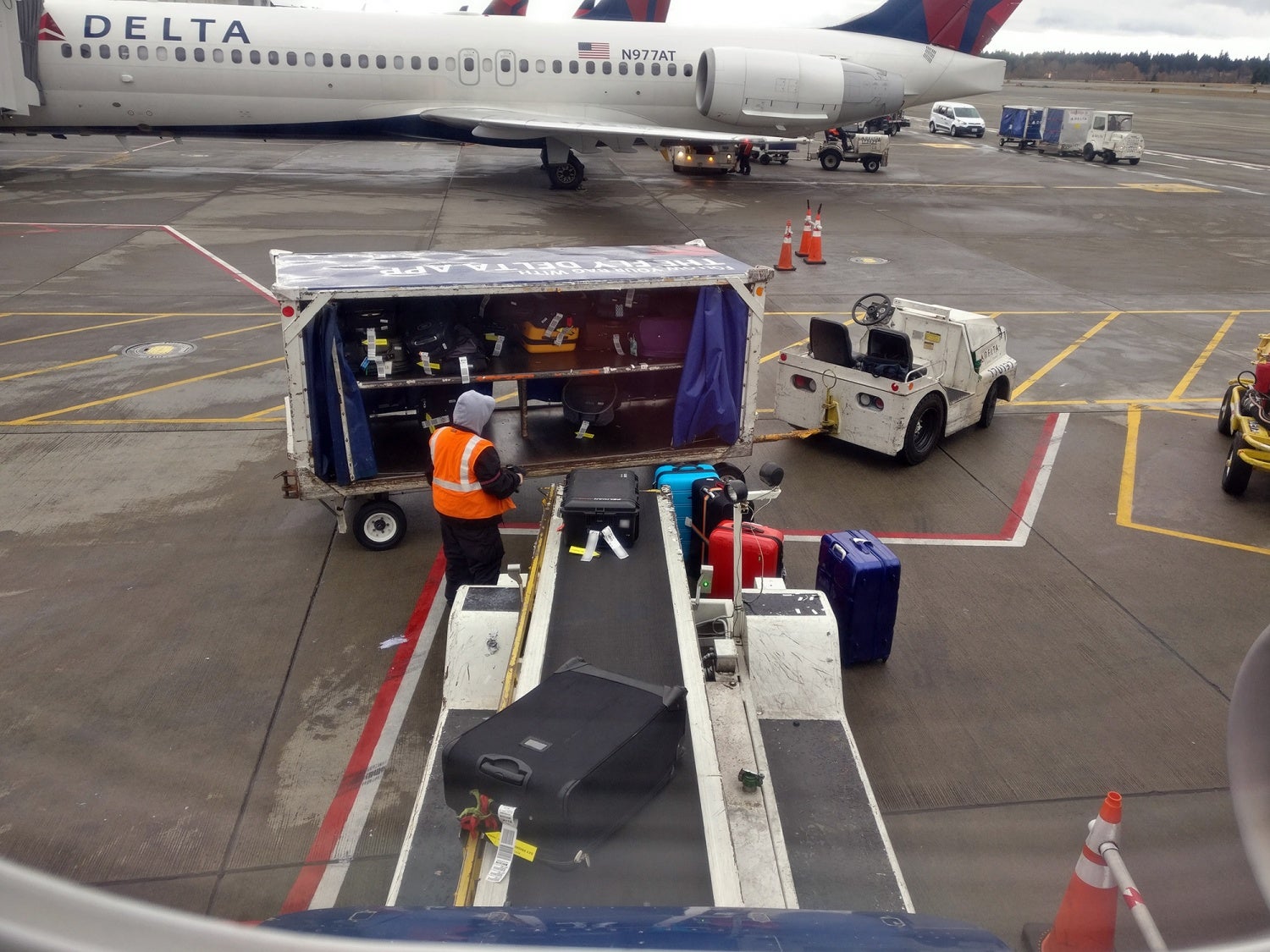
Locked luggage is safer luggage. Nearly all airport employees tend to be good, fine people… but the few who have thievery in their bones aren’t looking to steal an entire suitcase. They only seek to unzip something quickly and poke around inside.
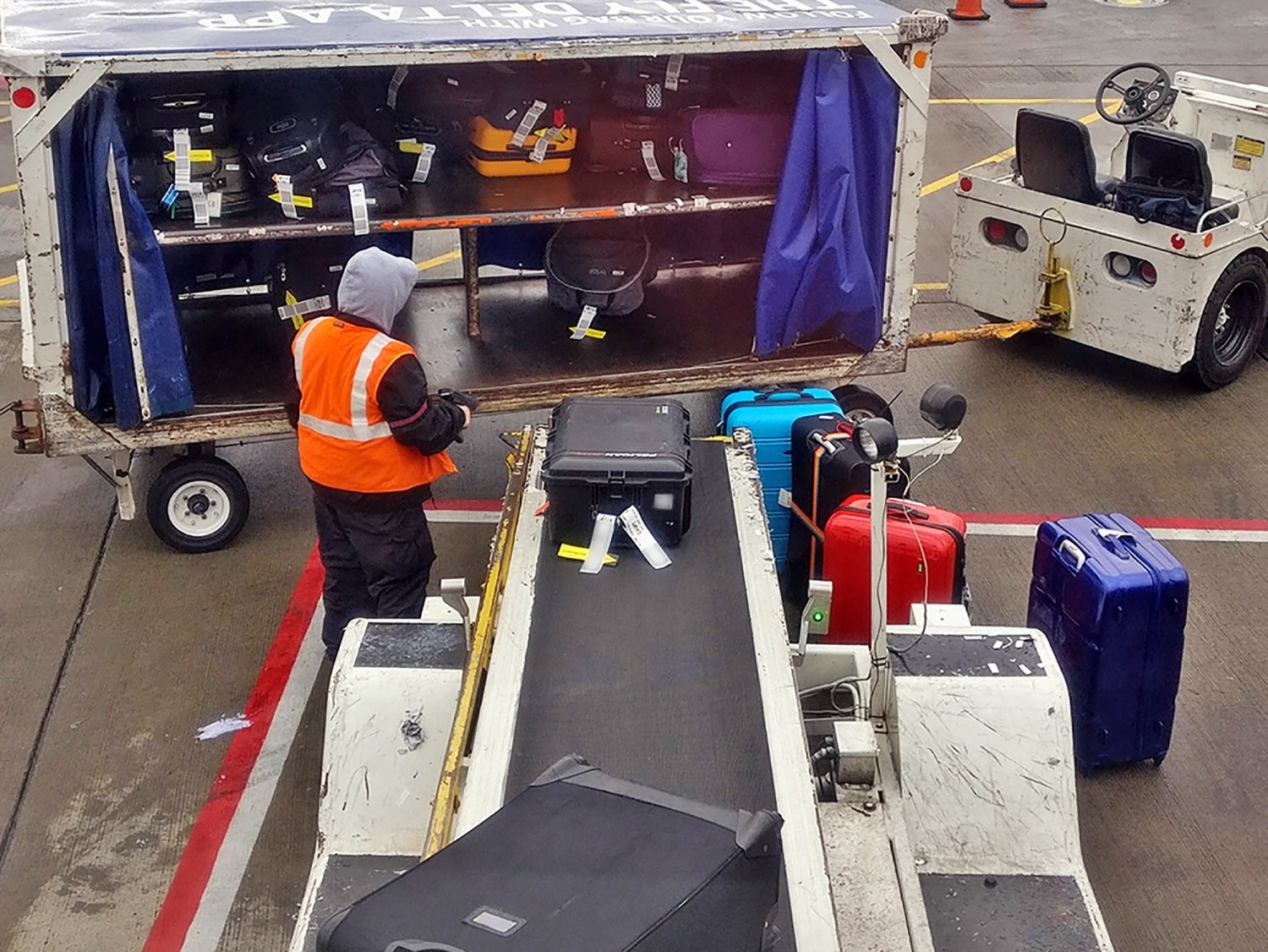
Whenever I see my padlocks on my Pelican case, I know that everything contained within is safe and secure, just as I left it.
When you travel as much as my associates and I do, sheer numbers dictate that once in a while your luggage will miss a connection or otherwise be subject to unexpected routing. The odds have caught up with me more than once. But even when I’ve had my luggage delivered via courier late that night or the following morning, I was able to rest easy knowing that it was locked the entire time.

A delivery service contractor dropping off the author’s locked luggage in Maryland.

A delivery service vehicle dropping off the author’s locked luggage in Florida.
The Basic Procedure and Requirements
Is Your Luggage Suitable?
As stated in the FAA’s and TSA’s documentation, linked above, firearms may travel in checked luggage provided that they are within a suitable hard-sided case. What makes something “suitable” in their eyes? The guiding principle which applies is that, once locked, it should be infeasible for someone to get a finger inside of the container. I have even seen TSA screeners apply this exact test to rifle and pistol cases.

This Pelican case was subject to some rough handling (or someone got a little curious about what was inside), and its latches were popped during travel. No matter, the locks are correctly applied, and the lid cannot open more than a fraction of an inch.

A TSA screener in Washington pops the latches on one of this author’s Pelican cases and attempts the “finger test” to ensure that the case meets the necessary criteria.
The hard-sided case may either be your actual piece of checked luggage, or it may be a smaller case, provided it is capable of being “locked” no matter how laughably.
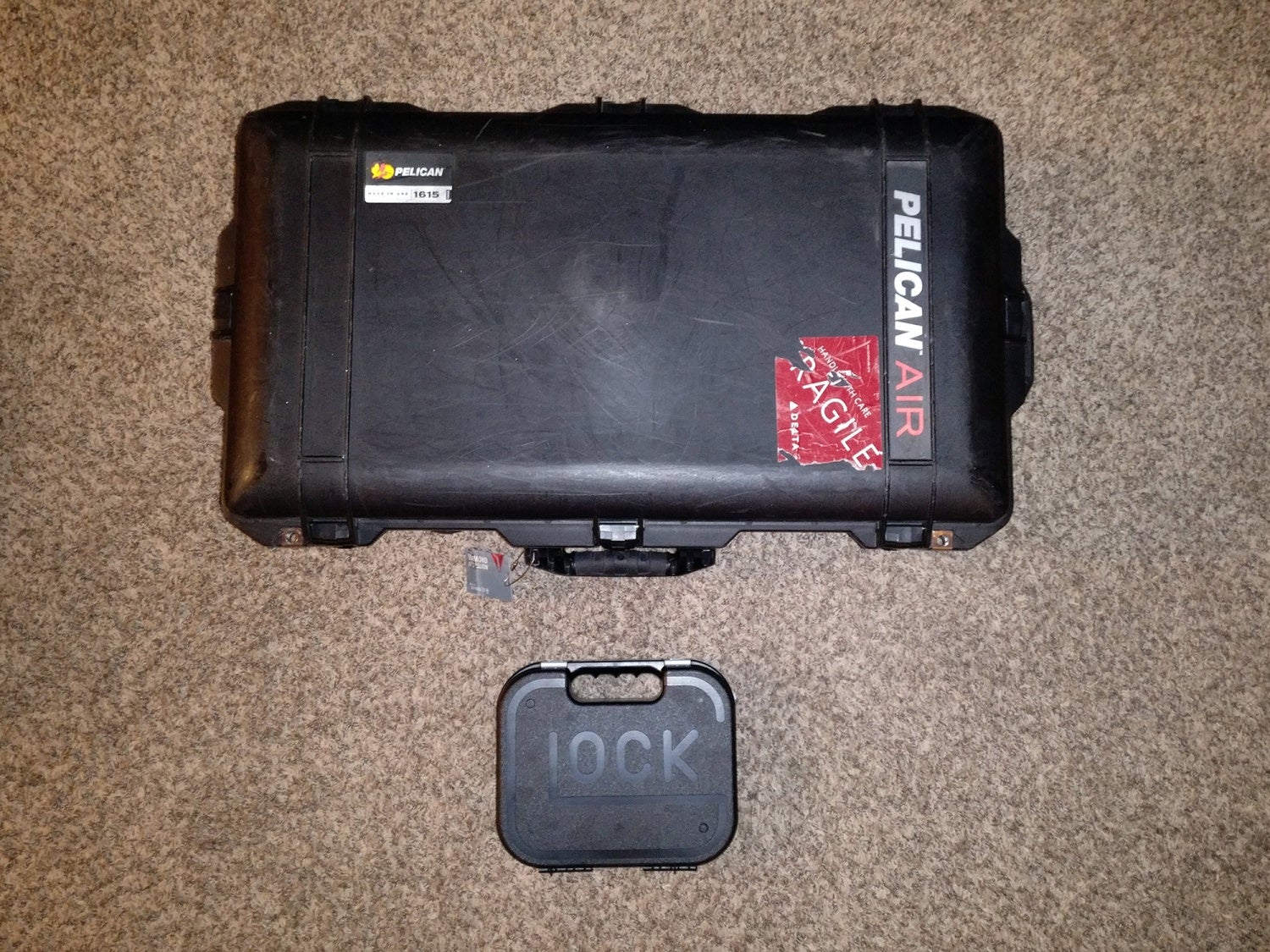
Both of these would satisfy the policy requirements of being hard-sided and capable of being locked. The Pelican case can accommodate two nice padlocks on its factory hasps. The OEM Glock box could, in theory, have a padlock with a small enough shackle clasped over its carry handles, and that might pass muster with the airport authorities. This author knows which case he prefers using.
As you can see, it’s quite possible to comply with the letter of the law but not the spirit of the law. I always personally opt for using large, hard-sided luggage because it affords not just protection to my firearm, but also to the rest of my possessions. If you pack a pistol inside of a small case stowed within a duffel bag or soft-sided luggage, you may be “locking up” your gun, but nothing else flying with you that day is being secured. I like leveraging the law in such a way that not only my carry piece but also my laptop, my clothes, my Dopp kit, and invariably a bottle of whiskey are all protected by the same locks and hard outer shell.
What Constitutes a Firearm?
As folk who have read some of my anecdotes are aware, when you are traveling to regions that are not so gun-friendly – or if you are checking multiple cases of gear and want them each to be secured but have little need for more than one pistol at your destination – it is possible to leverage the law in such a way that you lock all of your bags without actually checking gun after gun. Remember, the law says that all firearms must be checked in locked, secured luggage. What constitutes a firearm?
- Proper guns – Naturally, these qualify.
- Flare guns – Since they expel a projectile using a combustible propellant, they count, and are 50-state legal (Flares are not permitted in checked luggage, however. See next section.)
- Blank-firing guns – Well, they do go bang…and sometimes even wax or wadding may eject from the barrel. If they are manufactured to look like authentic replicas, most airports will treat them as the real thing and locked luggage rules apply.
- SIRT pistols? – This may be a stretch, but real-steel replica firearms and training guns often look “real” enough to airport workers and on x-ray scanners that it’s best to declare them as such when you’re flying. They wouldn’t typically qualify per se under the law, however.
- Airsoft Guns? – Sorry to all the Mall Ninjas out there, but you’re out of luck. If you want to lock your luggage, a KWA green gas M9 probably shouldn’t be your go-to checked pistol. If anyone realizes that it’s not a genuine firearm, they may not allow you to treat it as one. Be that as it may, don’t ever try to pack one in your carry-on luggage!
- Blueguns/Plastic Trainers – Again, these are obviously not actual firearms. Do not expect to reliably be able to lock your luggage if this is all you’re transporting. And as with the above category, do not expect logic or reason to apply at a passenger screening checkpoint. The TSA has confiscated water pistols and GI Joe accessories before for looking firearm-like. Do not have even a rubber replica in your carry-on bag. Yes, yes, I know you wanted to practice disarm drills with your Krav partners in the airport lounge while you wait for your flight. Sorry to rain on your parade…use a banana instead. The Sky Club gives them away for free.
- Magazines/Gun Parts – While you are forbidden by the TSA to bring these through passenger screening, I wouldn’t wager money on airport check-in staff being understanding in all instances if you’re trying to lock your luggage when it only contains an empty PMAG. I know folks who try this, and they have very mixed results. Remember, just because something is not allowed through passenger screening that does not mean it automatically qualifies for locked luggage treatment.
- Bare receivers – This is the most hilarious option, in my view. If you are truly only attempting to leverage the law for locking your luggage (again, maybe you’ve got your CCW pistol in one checked bag, but you also wish to secure an additional piece of luggage without a great deal of additional cost or weight) then using a bare receiver will fit the bill, at least on paper. I’ve had a few funny looks from airline workers before, and one time I had to call over an officer from the airport police unit who explained the law to them, but in the end any time I’ve had a lower or even a bare receiver in my one of my checked cases, airlines have treated it as a firearm.

In this photo, the author’s luggage does not contain any firearms.

In this photo, the author’s luggage contains a firearm and could be properly secured as lockable checked baggage.
What about Ammunition?
As long as you’re not traveling with anything too exotic, it’s perfectly legal and simple to fly with ammunition in your checked luggage.
What constitutes something exotic? In a nutshell: anything that starts to tread too closely in a bureaucrat’s mind to “dangerous explosives” as opposed to “commonly-used small arms ammo.” So all you black powder enthusiasts are welcome to pack your favorite muzzleloader, but a tin of loose propellant would be on the no-fly list. The same goes for modern smokeless powder, primers, caps, and all the other elements of our hobby that go bang. They are all verboten in your luggage unless loaded and pressed into conventional cased cartridges.
As mentioned above, while flare guns are all right in a checked bag, flares themselves are not. Likewise, tracers or other potentially incendiary ammunition are probably not going to be in explicit compliance with regulations. If anyone were to read the fine print on a box of shotshells and see the words “Dragon’s Breath” on them, you might be subject to comments like, “I’m sorry, but these can’t go on the plane. Also, be honest with me, sir…who really needs these?”
Up to eleven pounds of conventional cartridge ammunition is fine. Anything beyond .75 caliber (which in most materiel catalogs would start to be considered cannon rounds, frankly) will result in raised eyebrows and a polite explanation that you’re outside of permissible spec for ammunition in checked luggage. So your M61 Vulcan cannon could probably travel in the belly of an A330 beneath your seat, but you’ll have to acquire its food at your destination.
Folk who pack ammo on the smaller side may also have some difficulties that they may not expect. 22LR is commonly sold loose in bulk cartons as opposed to being arrayed in neat little rows within the manufacturer’s box. While this is fine if you’re merely transporting it from Cabela’s to the local range, it technically is not compliant with air travel. Why? Because ammunition in your checked luggage, per the federal guidelines, must be “securely packed… so no ammunition is loose or exposed.” If you are the type of person who likes to use reloaded or bulk ammo (of the thousands of rounds of 5.56 we have in our basement, at least half of it is Lake City surplus stuff that was shipped to me in bags) invest in some blue boxes from Dillon so that everything remains nice and orderly in your suitcase.
What Locks are Suitable?
As we have seen earlier, you can opt to comply with the letter of the law or with the spirit of the law. FAA and TSA guidelines state that guns should be locked such that “no one else has the key or combination.” Despite that guideline, I regularly see other travelers who use TSA-compliant locks on their firearm cases.

Here we see a passenger in line before me at a TSA luggage screening area. His Pelican 1720 case is visibly secured with nothing more than tiny TSA compliant locks. This author does not recommend that.
Personally, I always opt to secure my luggage using locks that have a high degree of resistance to covert entry. While I have on occasion had my locks completely cut off (something that will be detailed much more in part two of this series) whenever my luggage reaches its destination and the locks are still in place, I know for a fact that no one has tampered with my firearm or any other possessions inside of my case. By opting for locks that resist manipulation, bumping, shimming, and other such attacks, I can rest easy when it comes to the integrity of my belongings.
On occasion, I have encountered airline employees or even TSA workers who are of the mistaken belief that luggage locks should always be TSA-compliant, even if the luggage contains firearms. Many in the security community, however, are aware that the master TSA luggage keys have all leaked online, and that it is possible for effectively anyone to either 3D print them or order them from overseas vendors. It is not advisable to use TSA-compliant locks for any serious security needs, and that includes packing firearms in checked luggage.
This Does Not Make You a Special Snowflake
While there may be the occasional situation where checking firearms will allow you to skip past a long line (you can try tipping a skycap at the curb but then informing them that your luggage contains firearms and that you “heard that it’s not possible to do curbside check-in” and every so often they will escort you up to the check-in counter personally…this reportedly does not work as often as it used to) for the most part a passenger who is traveling with firearms is treated the same as everybody else.
That is to say; you are likely to be subject to all the same weight and size requirements for your luggage that everybody else is.
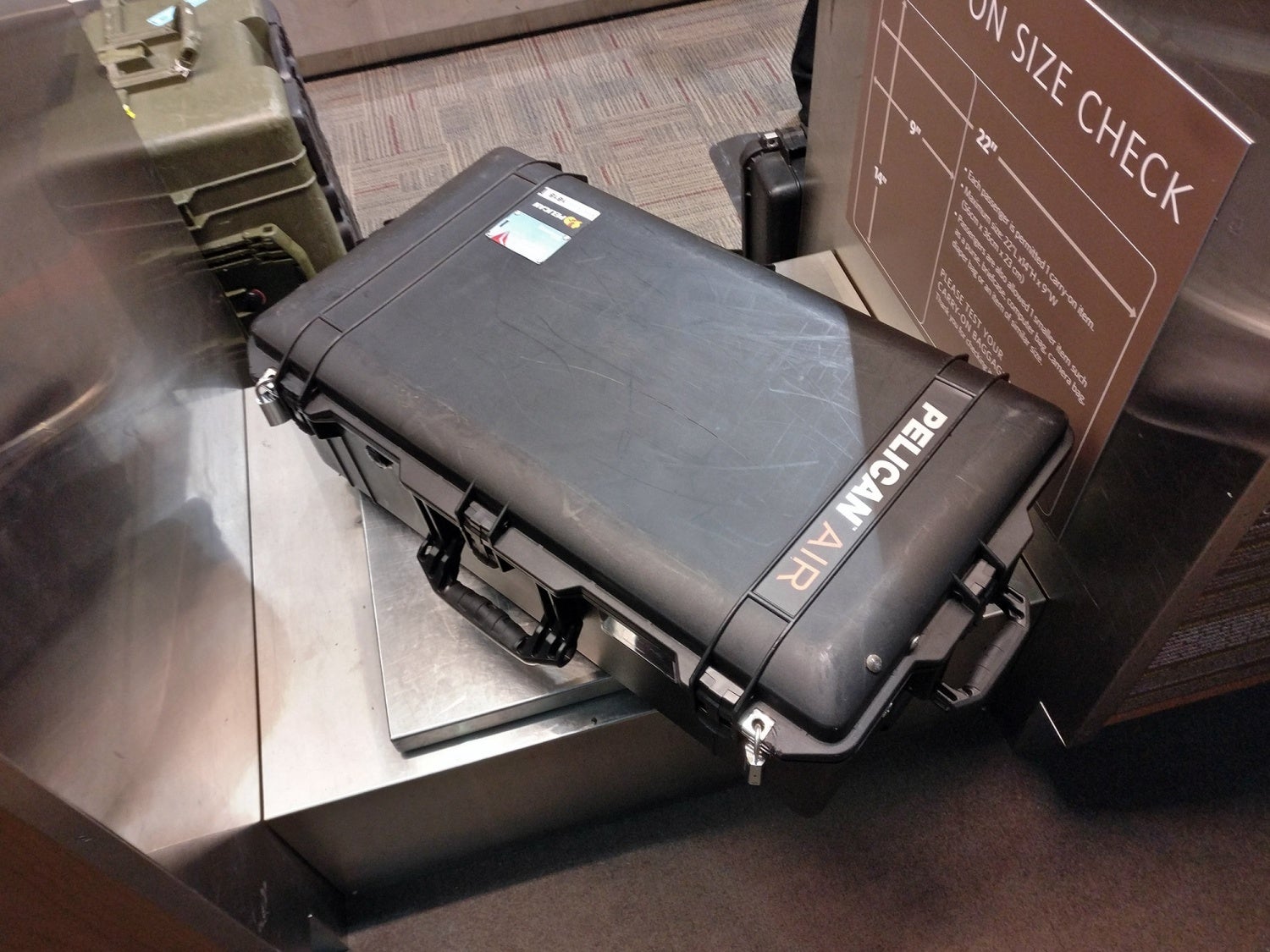
Expect your gun-case to be weighed, measured, and hopefully not found wanting. If your bag is beyond the accepted standards, you may be forced to pay for the overage. Having guns doesn’t exempt you from these requirements. NOTE – the new Pelican Air product line includes one model, the 1615, which is specially designed to be the maximum allowable luggage piece size that does not exceed “standard” checked bag dimensions.
While many airlines will have language concerning firearms on their website, under a section with a heading like “Sporting Equipment”, your luggage will not automatically be designated with such status. Expect that in most cases, your checked bag will be subject to the size and weight requirements as every other Samsonite or TravelPro suitcase on the market.
Declarations and Paperwork
Federal regulations state that a passenger who is transporting a firearm in their checked luggage must declare, either verbally or in writing, that they are doing so. In practice, you can reliably expect to do both.
When you approach the counter, during your check-in process, you will declare to the airline agent that you have a checked firearm in your luggage that day. They will give you a small card (typically orange, but not all carriers follow this standard) for you to fill out and sign, to attest that you have a firearm and that it is, indeed, unloaded.
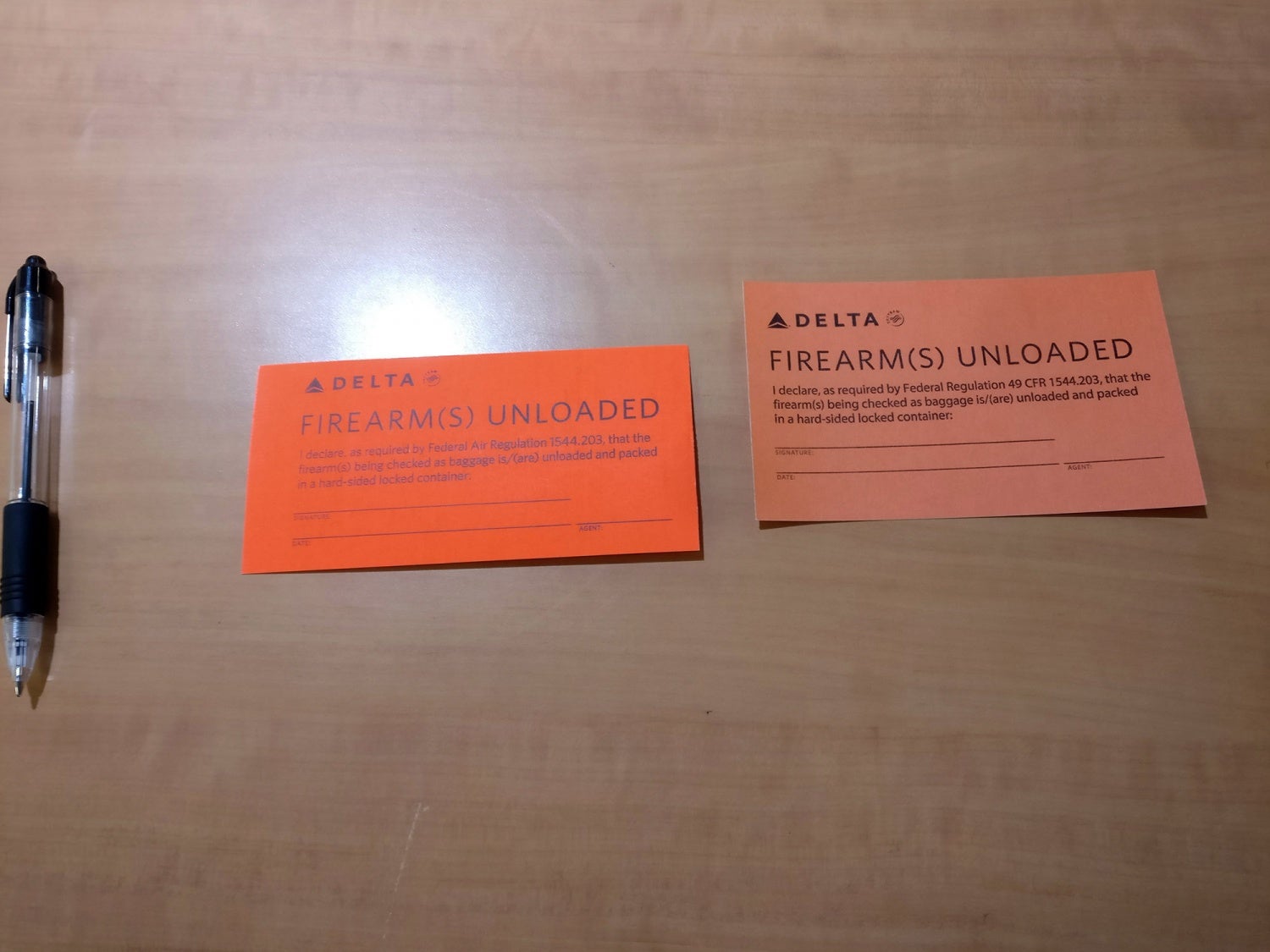
Two versions of Delta Airlines’ firearm declaration card. Older versions of such cards used by many carriers once incorporated small loops of string that would allow them to be affixed to the outside of a checked bag. That practice is no longer permitted.
Ideally, this card is supposed to be placed directly on the very top of your possessions within your luggage. Many airline employees do not understand this. Expect a great many of the check-in staffers whom you encounter to insist that the card should be inserted deep within your case, possibly inside of your range bag and right up against the gun itself. This is wrong.
Not only have all major air carriers moved away from the old practice of asking passengers to demonstrate the cleared status of their firearm (it once was commonplace to rack slides or swing out cylinders right there in the check-in hall…this practice was abandoned to reduce possible alarm among the lesser-educated masses who may be nearby and also to speed the process along) but they all now have policies which outright discourage passengers exposing or handling firearms at the check-in desk. Furthermore, most declaration cards are bright orange specifically so that they will be immediately visible atop all other personal effects in a piece of checked luggage. If a TSA screener or airport worker opens a piece of luggage for any reason, the card’s high visibility and position should serve to immediately indicate to them that there are firearms present and greater care should be taken with this bag.
Ultimately, is it worth getting into an argument with the check-in staffer if they dig in their heels and insist that you bury the orange card beneath your boots, toiletries, and travel chargers? Probably not. But this does lead us quite nicely to our next topic…
Variations Between Airlines
When to Expect the Unexpected
Not every air carrier accommodates checked firearms in the same exact way and with identical policies. While federal regulations are clear as to what is permitted, be prepared for occasional differences from one carrier to another. Some airlines limit the number of firearms that can be in a single checked bag. Others may be fussy about whether an empty magazine can remain inserted into a gun while still considering the firearm “unloaded” (don’t laugh, I had an honest-to-god ten-minute argument with a United employee over this exact point).
Most of the confusion and variation from one carrier to another pertains to ammunition and ammunition feeding devices. The FAA and the TSA are quite clear on this topic, with the regulations written in an accommodating manner.

The government specifically recognizes magazines as a suitable means of transporting ammunition in checked luggage… provided that the magazines either have cover plates (like PMAG dust covers) or they are in single-sleeve magazine holsters. As long as there is no “exposure” of rounds, you are compliant. This author has logged countless flights with his carry pistol in a range bag, next to which were arrayed a handful of loaded magazines, each inside of a nylon mag holster which was velcroed shut.
Hello My Name Is: Boom Stick
Officially, according to regulation and policy, all common carriers (this goes for everyone from UPS to FedEx to Delta to JetBlue) transporting firearms from state to state shall not “require or cause any label, tag, or other written notice to be placed on the outside of any package, luggage, or other container indicating that such package, luggage, or other container contains a firearm.” (27 CFR 478.31b)
That being said, it is quite common for air carriers to mark designed luggage with special codes, both within their electronic systems as well as on the luggage tags themselves.
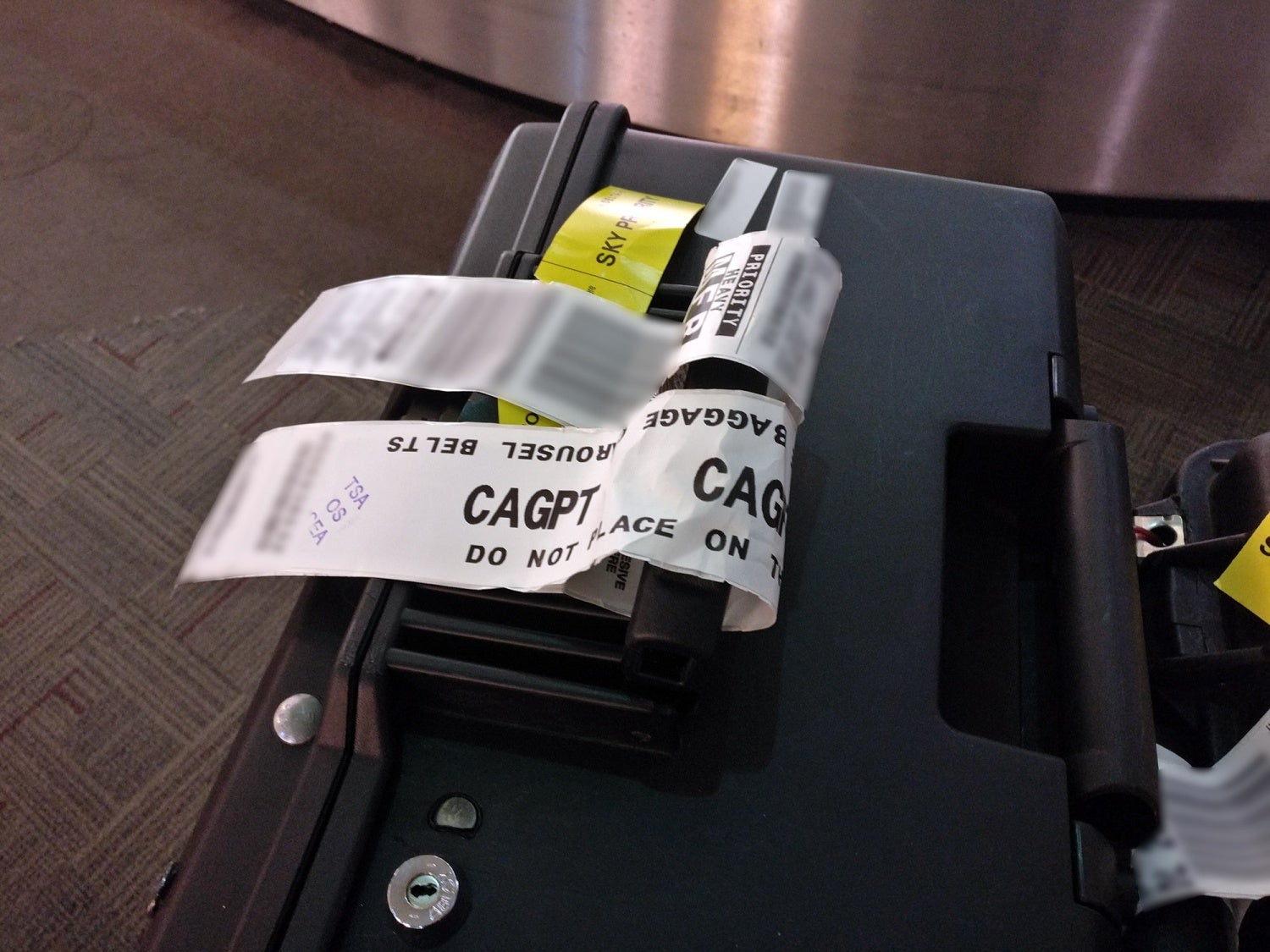
Next to the conventional Delta luggage tag we see there is also attached a secondary “CAGPT” tag. Specifying to all airline workers that the should “check and give protection to” this luggage, it represents high-value cargo. While this isn’t an explicit indication of firearms in the case per se, it is common knowledge that in almost all instances, such a case is a gun case.

Here we see the “CAGPT” designation called out in an even larger and more permanent way. More than once, this author has seen airport workers pull out these oversize stickers, and then slap one onto his Pelican case before he could even muster a quizzical glance in their direction.
You Can’t Get There From Here
Once you complete your business with the check-in agent at the airline counter, many times (but not always) your luggage will have to be transported to a special area for TSA screening. On occasion, a skycap or a porter from a third-party airport contracting firm will be assigned the duty of escorting you there. If no such person is available, you’re on your own. Here’s hoping you didn’t surrender your luggage cart if you were using one earlier!

An airport worker from a third-party contractor like G2 or AirServ may be assigned to help you convey your luggage to the TSA screening area if it is far away or on another level of the terminal.

If you were relying on a luggage cart to get your firearm cases from the car to the counter, keep an eye on it while the airline staffer is checking you in… you might need to use it to get to a secondary processing area where the TSA screens luggage.
If My Luggage is Locked, How Does it Get Screened?
Luggage screening is a much larger topic, and there will be a great deal said about this in the second installment of this series. However, understand that your luggage will be subject to the same standards of security screening as all other travelers’ checked bags. It may entail your luggage being sent through a CTX machine. It might be as brief and non-invasive as a swab test. Or you may encounter a TSA staffer who, without any such technology at their disposal, is tasked with opening your case and pawing through everything inside. Every airport is different.

Here we see one of the best scenarios you can encounter for luggage screening: a TSA employee sends your gun cases through a scanner while you stand by and can observe the process. There should be no need to unlock or open your cases unless something alerts, and typically you are afforded priority and will have your luggage processed before all the other car seats and sports equipment which may be languishing there in the oversize screening room queue.
Package Deliveries, Please Use Side Door
One final variable when flying with firearms is where your luggage will ultimately appear at your destination. In the past, it was commonplace for conventionally-sized luggage (whether or not it contained firearms) to simply come out on the baggage carousel. Long rifle cases have always been something of a crapshoot…sometimes they would appear amid the rest of the bags on the rotating belts. At other times they would appear at a side door, elevator, or separate zone entirely…wherever “oversize” or “special” luggage was slated to come up from the apron.

Will your gun case appear here? Short answer: Maybe. Long answer: Shoulder shrug. You’d better ask an airline employee and potentially still expect a puzzled look and noncommittal response.
Nowadays, however, more and more air carriers appear to be singling out firearm-laden luggage for special treatment at the destination. If you do not immediately see your gun case in the claim area, check with your airline’s Baggage Service Office. There’s a good chance they may be holding it there. Some strong libertarians and privacy advocates may object to the fact that it’s now commonplace for airline staff in the BSO to ask to see your ID or your luggage claim ticket before they will release your gun case to you. I once felt this way, but now I honestly appreciate the concierge-style service this affords us. My wife and I tend to be among the first people to deplane at any destination, but instead of hustling double-time to the bag claim, we now frequently stop in the Sky Club for a drink or snack or simply to use the head… we don’t have to worry about someone else swiping our luggage when the crowd down by the baggage carousel begins to disperse; we know that (usually) the rampers have brought our Pelican cases directly to the BSO and that our bags will be waiting there whenever we make our way down to that part of the terminal.
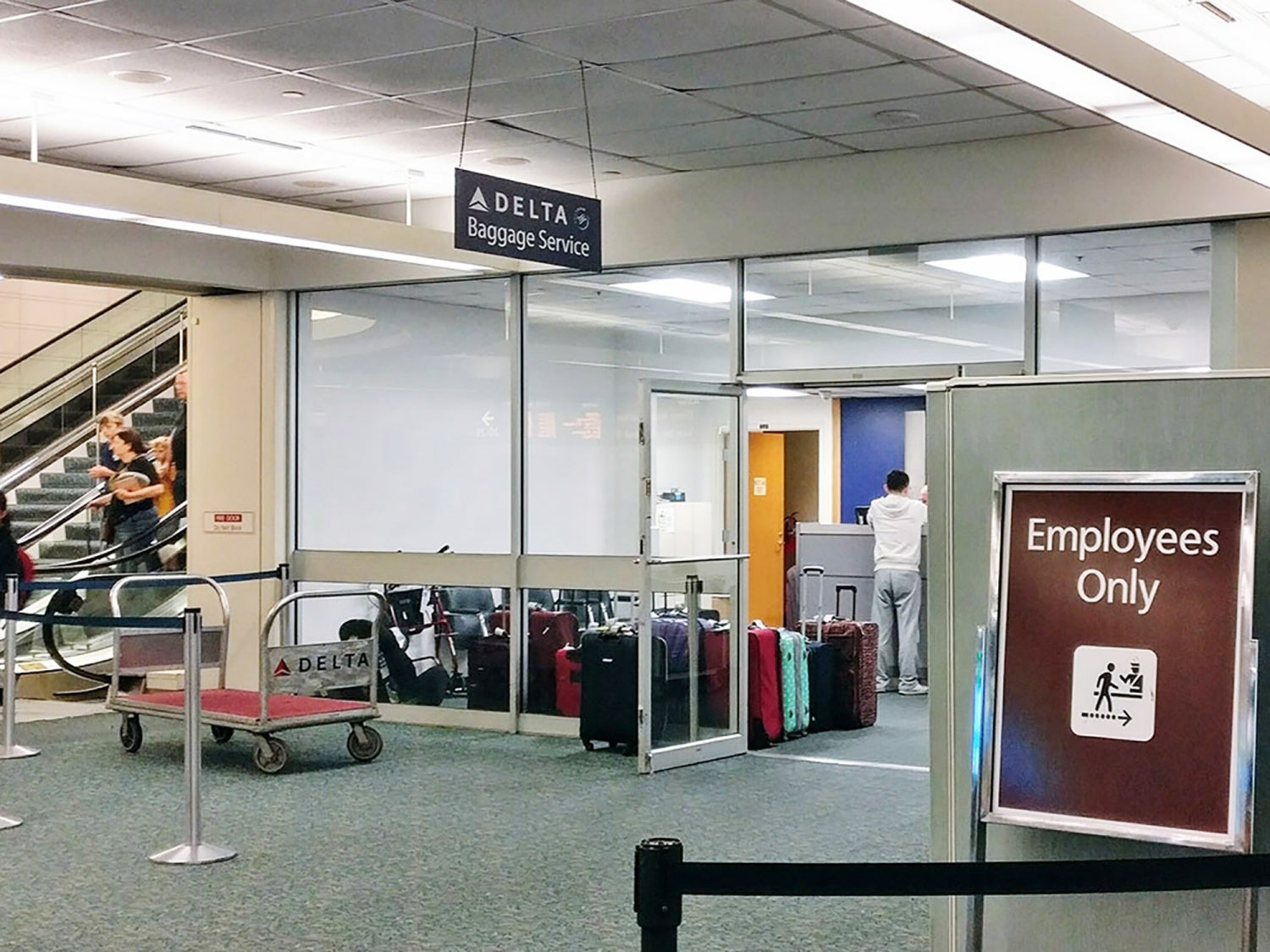
Can’t spot your gun case on the regular baggage carousel? Already had a look down at the oversize belt? Ask at the Baggage Service Office…they may be holding it there for you.
Should I Be Nervous About All This?
Far and away, the most frequent thing I hear from readers who write to me tends to be, “I was a bit worried since this was my first time flying with firearms and I didn’t know what to expect, but everything went so smoothly! It turns out I didn’t have anything to worry about!”
In this article, I’ve tried to cover most of the typical oddball problems that can crop up from time to time, but for the most part, flying with firearms is easy. Do not hesitate to try it. In the end, if you allow yourself a little extra time (so you can see how your airport does things) and if you’re calm and polite (don’t abruptly shout to the airline employee, “I’ve got a gun!” during check-in… simply state, “I have to declare a firearm in my checked luggage today”) all should turn out just fine.
One additional tip I can offer, which is not only for your peace of mind but also simply good practice, is to keep your luggage locked at all times whenever possible. When you alight from your car at the curb, the luggage should be locked. When you approach the counter, keep it locked until directed to insert the declaration card. In this manner, not only are you sure to be doing your best to comply with any local laws, but you also don’t run the risk of an airport staffer mistakenly tossing your bag onto a moving conveyor belt as you watch it whisk away to a dark tunnel leading elsewhere, with your firearms unsecured.
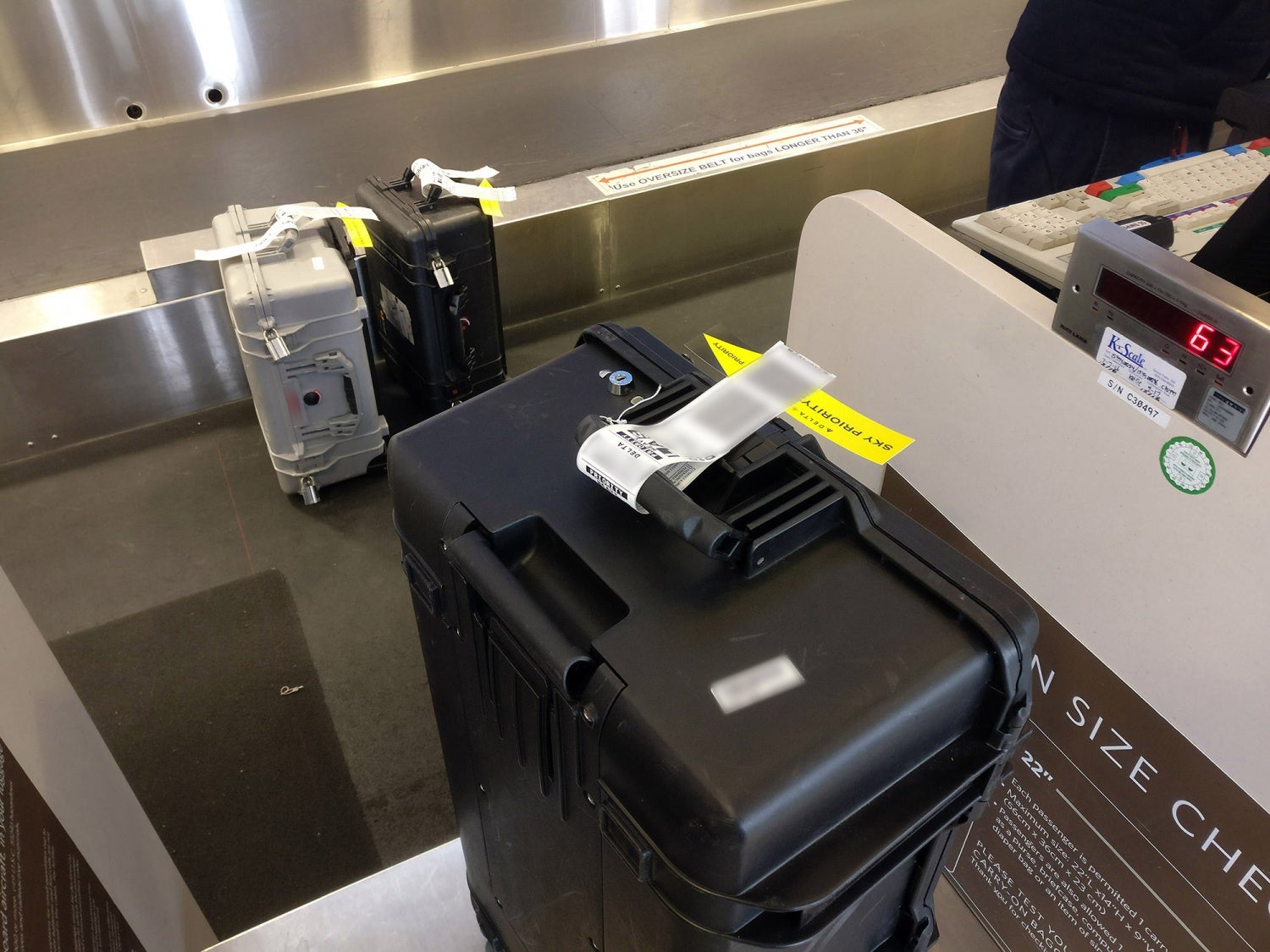
Keep your luggage locked during the whole check-in process. Right now, these Pelican cases are inches from that moving belt and a careless or distracted worker might toss them on there, unaware that they contain firearms.
I mentioned local laws above, and I should specify that if you live somewhere particularly un-free, it’s not a bad idea to speak with your air carrier, the airport, or even potentially a lawyer before you fly. I have personally flown with firearms into and out of airports in all 50 states (except for Delaware, which has no commercial airport) without incident. Yes, I have flown into and out of Chicago. Yes, I have flown in and out of New Jersey. And, yes, I have flown into and out of New York City.
Famous for its hardline stances against large sodas, loose cigarettes, open containers, and (of course) firearms, there’s no shortage of horror stories from air travelers who attempted to fly into or out of LGA or JFK and wound up caught in a Kafkaesque nightmare of bureaucracy, police reports, and often handcuffs. Let me be clear: New York is no joking matter when it comes to firearms. If you do not know what you are doing, it’s easy to run afoul of laws and face serious fines or jail time.
That said, the “Safe Passage” provision of the Firearm Owners Protection Act of 1986 has been interpreted to apply to air travel. This means that if you inform the airline employees (and, most likely, you will also have this same conversation with police officers from the airport unit) that you are merely transiting through New York City and that you did not stay the night in New York City, it is acceptable for you to be in a terminal at LaGuardia or Kennedy International with firearm-bearing luggage.

A visibly-distressed Delta Employee, Sandra, placed a call to airport security when this author was flying with firearms out of JFK. Here, an Officer of the NYC Port Authority police inspects the author’s luggage and checked firearms.

While airline workers and TSA screeners may have been instructed never to handle firearms, the NYC Port Authority is not so shy. Here we see the Officer visibly brandishing the author’s M9 pistol in the airport terminal as he writes in his PNB. He was satisfied only after recording serial numbers of the handguns and inquiring whether any of the firearms had been in New York overnight.
Last but not least, be mindful of local laws and your overall surroundings when you exit the terminal at your destination. Large, hard-sided Pelican cases (particularly ones with padlocks affixed) can be a target, and you don’t want to attract unnecessary attention from nosy authority figures or from folk who wish to pry too much into what you may be transporting.
If my Lyft driver or the staff at the rental car counter asks me too many questions, I explain that “I’m in town with the band” and pass off my luggage as being “equipment cases” and nothing more. When you’re finally getting to your hotel or place of business, it’s up to you to determine whether or not you still need padlocks visibly dangling from your bags.

These padlocks gave me peace of mind while I was flying. But as soon as it’s legal to do so, I often opt to take them off my luggage. Every situation is different, and every situation dictates a varying degree of discretion and anonymity.
Have You Got a Flying with Firearms Story to Tell?
For years now, I have been maintaining a website full of accounts from travelers who have flown with firearms. I may not keep it as up-to-date as I always want to, but if you have an experience of packing in the friendly skies that you’d like to share with me, I’d love to hear from you. If you send me an email with details of how you were treated on your journey, I’ll add it to the published accounts page.
What if Something Goes Wrong?
As this whole piece has attempted to convey, flying with firearms is generally a pleasant and hassle-free experience. We have many freedoms in America, and our uninhibited freedom to travel from place to place, even while bearing guns, is still one of them (most of the time). I hope that this guide covers enough key points and offers sufficient advice that any of you who were on the fence about flying with your guns will opt to do so in future.
That said, not every experience is smooth sailing. In part two of this three-part series, we will explore instances when this did not go according to plan. You don’t get to put up the miles that my associates and I do without running into some really rotten days in airports. Let me tell you about them so you can learn how to respond if your luggage is mishandled, your locks are cut off, or your firearms are damaged or stolen outright.
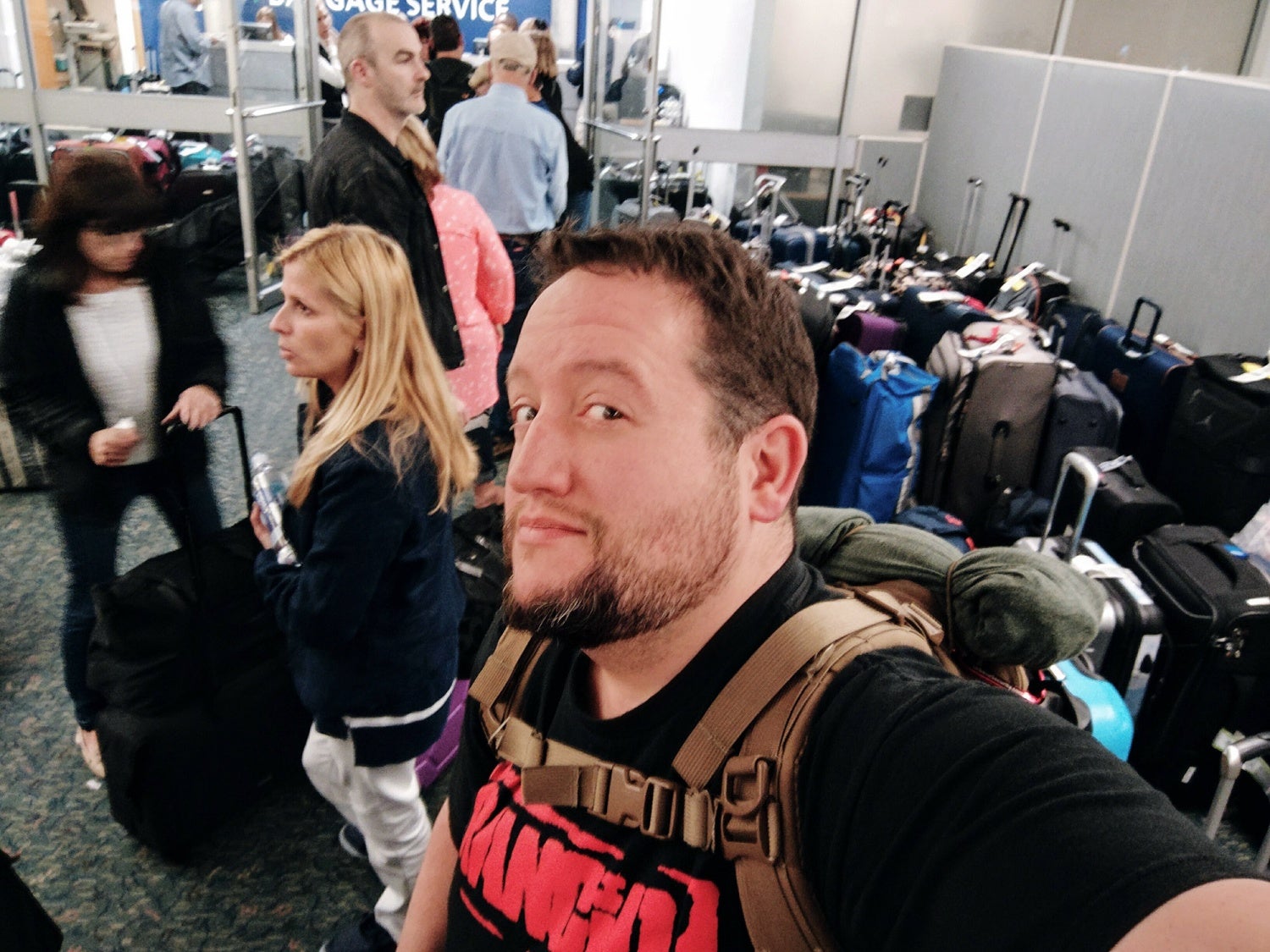
No one in this photograph is having a good day, the author included. While most of these people are worried about finding spare socks or buying a replacement toothbrush, this author is currently missing an M1A rifle four times more valuable than his car.
Until then…see you at whatever bar or shooting range is nearest to the airport where I land.
Editors Note: Parts 2 (“When Things Go Pear Shaped”) and 3 (“The Zip Ties of Freedom”) will follow along in the next couple of days.
 Your Privacy Choices
Your Privacy Choices
